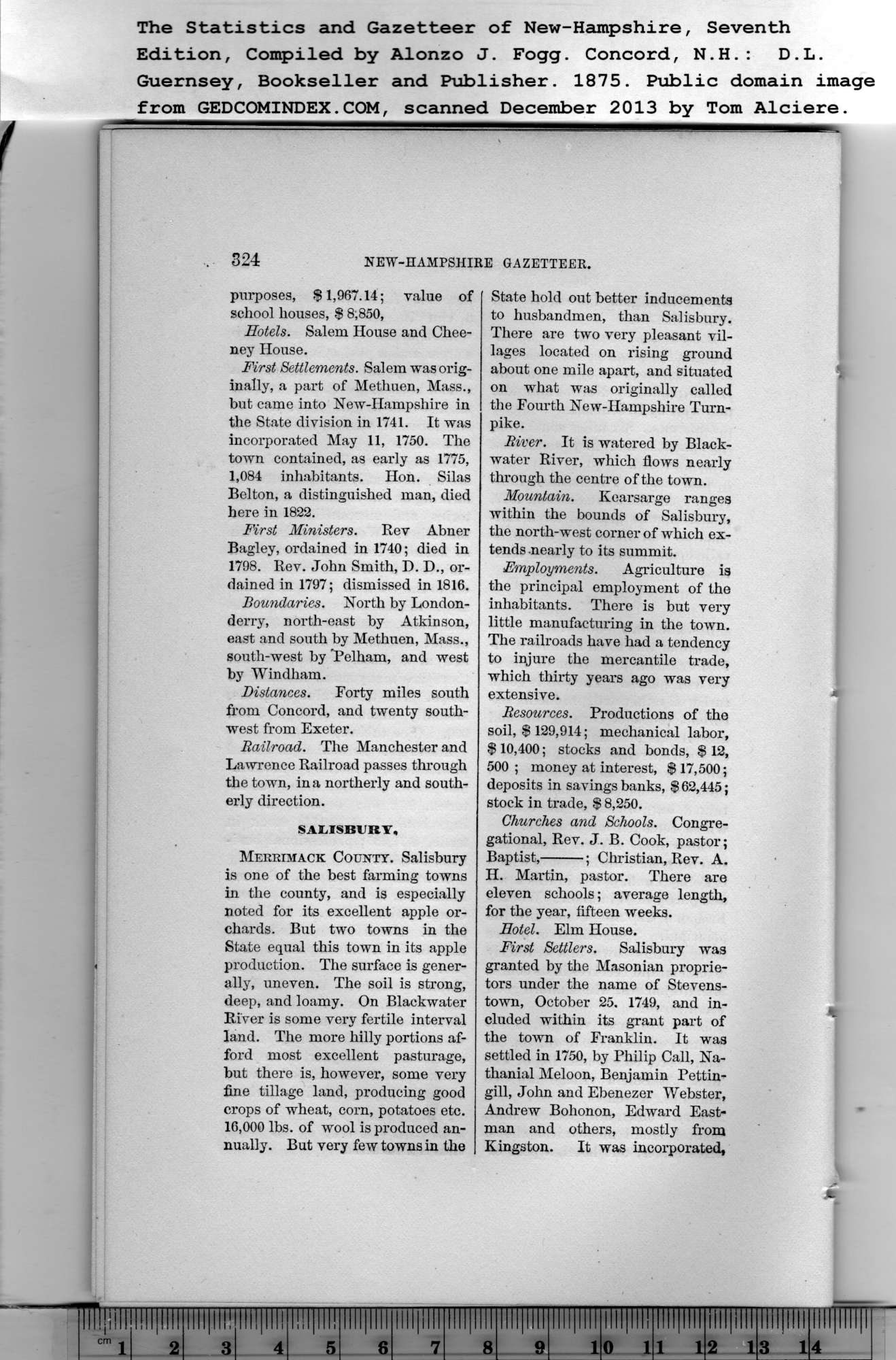|
purposes, $1,967.14; value of
school houses, $ 8,850,
The Statistics and Gazetteer of New-Hampshire, Seventh
Edition, Compiled by Alonzo J. Fogg. Concord, N.H.: D.L.
324 NEW-HAMPSHIRE GAZETTEER.
Hotels. Salem House and Chee-
ney House.
First Settlements. Salem was orig-
inally, a part of Methuen, Mass.,
but came into New-IIampshire in
the State division in 1741. It was
incorporated May 11, 1750. The
town contained, as early as 1775,
1,084 inhabitants. Hon. Silas
Belton, a distinguished man, died
here in 1822.
First Ministers. Rev Abner
Bagley, ordained in 1740; died in
1798. Rev. John Smith, D. D., or-
dained in 1797; dismissed in 1816.
Boundaries. North by London-
derry, north-east by Atkinson,
east and south by Methuen, Mass.,
south-west by Pelham, and west
by Windham.
Distances. Forty miles south
from Concord, and twenty south-
west from Exeter.
Railroad. The Manchester and
Lawrence Railroad passes through
the town, in a northerly and south-
erly direction.
SALISBURY,
Merrimack County. Salisbury
is one of the best farming towns
in the county, and is especially
noted for its excellent apple or-
chards. But two towns in the
State equal this town in its apple
production. The surface is gener-
ally, uneven. The soil is strong,
deep, and loamy. On Blackwater
River is some very fertile interval
land. The more hilly portions af-
ford most excellent pasturage,
but there is, however, some very
fine tillage land, producing good
crops of wheat, corn, potatoes etc.
16,000 lbs. of wool is produced an-
nually. But very few towns in the |
State hold out better inducements
to husbandmen, than Salisbury.
There are two very pleasant vil-
lages located on rising ground
about one mile apart, and situated
on what was originally called
the Fourth New-Hampshire Turn-
pike.
River. It is watered by Black-
water River, which flows nearly
through the centre of the town.
Mountain. Kearsarge ranges
within the bounds of Salisbury,
the north-west coi'ner of which ex-
tends nearly to its summit.
Employments. Agriculture is
the principal employment of the
inhabitants. There is but very
little manufacturing in the town.
The railroads have had a tendency
to injure the mercantile trade,
which thirty years ago was very
extensive.
Resources. Productions of the
soil, $ 129,914; mechanical labor,
$ 10,400; stocks and bonds, $ 12,
500; money at interest, $17,500;
deposits in savings banks, $ 62,445;
stock in trade, $ 8,250.
Churches and Schools. Congre-
gational, Rev. J. B. Cook, pastor;
Baptist, ; Christian, Rev. A.
H. Martin, pastor. There are
eleven schools; average length,
for the year, fifteen weeks.
Hotel. Elm House.
First Settlers. Salisbury was
granted by the Masonian proprie-
tors under the name of Stevens-
town, October 25, 1749, and in-
cluded within its grant part of
the town of Franklin. It was
settled in 1750, by Philip Call, Na-
thanial Meloon, Benjamin Pettin-
gill, John and Ebenezer Webster,
Andrew Bohonon, Edward East-
man and others, mostly from
Kingston. It was incorporated, |
